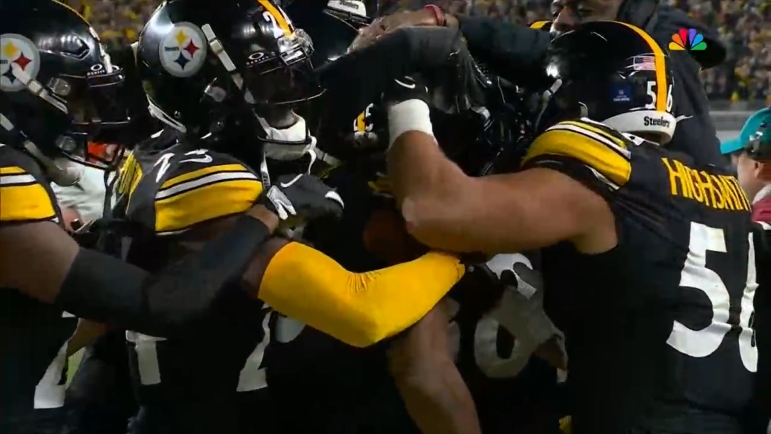Amid injury issues plaguing the back seven, the Pittsburgh Steelers relied heavily on their simulated pressure packages to maintain sound, zone-coverage structure on the back end in Week 16. In the secondary, Patrick Peterson saw extensive action at safety, often accompanied by Eric Rowe, with contributions from Elijah Riley and longtime special teams ace, Miles Killebrew. While edge depth remains intact, an early injury to Elandon Roberts left the Steelers light at off -ball linebacker, where they were forced to rely on the trio of Mark Robinson, Mykal Walker, and Myles Jack.
Left with a rotating cast of unfamiliar faces on the back end, Mike Tomlin, Teryl Austin and Co. kept the coverage menu simple on the back end, with a game plan heavily featuring Cover 3 and Tampa 2, with occasional sprinkles of Cover 1 and red zone-specific calls. Even with a simplified approach on the back end, Pittsburgh was able to confuse Bengals QB Jake Browning and Co. with its use of “creepers”, also commonly referred to as simulated pressures.
One of the fastest growing concepts in modern defensive football, simulated pressures are commonly defined as any four-man pressure concept that does not utilize the traditional four-down rushers. For the purposes of this article, we will be looking at four-man rushes both of the simulated pressure variety and those in which Pittsburgh populated the front to disguise a rush before stunting the defensive front.
Cover 3 Sim Pressures
While the Steelers traditionally run their creeper pressures from sub-package deployments, they will utilize these concepts out of base defense as well. Here, Pittsburgh aligns in a Tite front (4i – 0 – 4i), with two 9- tech OLBs playing on the outside shade of the TEs, showing a single-high structure with Eric Rowe rolled down on the No. 2 receiver to the passing strength.
While Browning is likely anticipating either Cover 3 or Cover 1 based on tendencies, Pittsburgh drops both edge players into coverage, with Elandon Roberts blitzing the A gap from depth. With both ends wrapping to contain, and Montravius Adams crossing face on the center, the Steelers are able to maintain a sound four-man pass rush cage, all while dropping their field side overhang to the strong hook and their boundary overhang to the weak flat.
Best of all, sim pressures are able to create confusion and dictate where the Bengals set their protection. Roberts is able to get an advantageous 1-on-1 matchup with a running back despite Pittsburgh rushing just four versus a six-man protection scheme. With pressure forcing the ball to come out quick, and sound coverage on the back end, Pittsburgh is able to rally and tackle the checkdown short of the sticks.
Later on the same drive, Pittsburgh comes back to the same simulated pressure concept from its base package, this time with Cincinnati countering with five-man protection up front. As Roberts gets caught creeping toward the line at the snap and is identified by the protection, the pressure is not as effective. Regardless, Pittsburgh is still able to establish an effective four-man pass rush cage while dropping both overhangs into coverage.
Once again, with seven in coverage on the back end in a traditional Cover 3 structure, Pittsburgh’s back seven does a nice job of communicating, and playing top down on routes, forcing Browning to hit a shallow crosser. Alex Highsmith, whose initial drop to the flat canceled the quarterback’s first read on the wheel to the back, is able to plant, drive, and dislodge the football with a violent stick. Simulated pressures are able to frustrate not only the offensive line through sending rushers from unpredictable angles, but also quarterbacks, who are not used to seeing players from the defensive front drop into coverage.
Now, working from its sub-package, in an over front (3 tech and a 2i on the interior, two stand up edge players), Pittsburgh goes back to the same pressure, this time dropping out the field-side overhang to the strong hook zone while sending Mykal Walker from depth. Once again, even while sending just four, Pittsburgh is able to get an off-ball linebacker in an isolated matchup with a back in pass protection.
This collapses the pocket quickly, depriving Browning of a lane to step up and escape early edge pressure from Highsmith, thus forcing an errant decision. In this case, Pittsburgh opts to run a Cover 9 sim pressure (weak safety rotation away from the passing strength), leaving Eric Rowe in a “sky” rotation to the weak flat. Rowe does a phenomenal job of immediately pushing for width and depth to effectively midpoint the flood concept into the boundary, ultimately using his zone eyes to sink and pick off the crosser coming from the strong side.
Late in the game, with the Steelers in a sub-package even front (9-2i-2i-loose 5), they go back to the same sim pressure concept that they had success with all day. At this point in the game, Pittsburgh has won the chess match up front, and has Cincinnati’s pass protection schemed up to the point where it can generate an advantageous 1 v 1 matchup with a running back at all times. Naturally, the Bengals’ counter to this is to put a tight end in the backfield to get a bigger body in pass protection, rather than accounting for schematic deficiencies midgame.
In this Cover 9 Sky pressure, Myles Jack hits the open B gap from depth, while Keanu Benton wraps all the way from his 2i (inside shade on the guard) alignment all the way to contain to reform the pass rush cage. Highsmith, meanwhile, pops up from a three-point stance and works for width and depth as the strong hook defender. As Joey Porter Jr does a nice job of staying on the top shoulder of the post route, Rowe effectively plays high to low as the weak flat defender, sniffing out the over route. With a checkdown out of the question on third and long, Browning once again steps up and makes an errant decision.
Highsmith, playing with zone eyes and great depth, works laterally and falls right into the window for another timely interception. Once again, it is important to emphasize that Pittsburgh essentially played basic variations of Covers 3 and 9 all game, but its ability to be interchangeable in pressure and coverage personnel was enough to cause confusion.
Four-Man Stunts and Movement
While sim pressures are a growing part of any team’s defensive identity, Pittsburgh features arguably the league’s best pass-rush tandem at the edge position, and there are creative ways to exploit protections while utilizing just the traditional front four as well. Here, Pittsburgh is back in the sub-package over front, showing a two-high structure on the backend, with Jack lurking near the line of scrimmage and presenting himself as a potential blitzing threat.
At the snap, Pittsburgh spins to an inverted Cover 3, with both safeties (Patrick Peterson and Rowe) buzzing down to play as hook/curl zone defenders while Miles Killebrew works from linebacker depth back to the post. Jack, meanwhile, rotates from in the box out to the flat, pushing for width and depth. Up front, Montravius Adams and Highsmith execute a TEX stunt (Tackle-End-Exchange), generating a quarterback hit and forcing Browning to throw under pressure.
Overall, once the tight end stays in pass protection, Porter must identify that the No. 2 threat to his side has canceled, and he can slow his bail as Cover 3; he essentially plays as man to a single receiver side. Likewise, Jack should work to gain more depth and get into the comeback window, only rallying to the flat once the pin is pulled. Personally, I love this inverted Cover 3 concept on third and long because you allow your safeties to plant their heels at the sticks and aggressively trigger on anything thrown short of the sticks.
Pittsburgh has gotten plenty of mileage out of its load front this season. Here, the Steelers load the front to the defensive left in an attempt to force protection to slide away from Highsmith, getting him in an isolated matchup on the edge. While this has been a successful front for them all year, against Cincinnati, they threw in a wrinkle up front.
Playing traditional Tampa 2 on the back end, Cam Heyward and T.J. Watt execute a TEX stunt to the Load side, while Highsmith executes a coffee house stunt to perfection. As a result, interior pressure from Watt forces Browning to escape to his left, leaving him to be chased from his blindside by an unblocked Highsmith.
Once again in the face of pressure, Browning attempts to throw the ball into the stands, but it winds up in the hands of a waiting Patrick Peterson for another takeaway. A subtle detail, but Porter gets caught biting inside here, which leaves him overleveraged on the Chair 7 concept.
Cornerbacks are taught to play on a cliff and are given two shuffles in either direction before they must make an in-call and pass the route to the adjacent curl defender. While he has shown great strides in man coverage and is clearly a building block of this team’s future on defense, he still has plenty of room to grow in terms of executing basic zone assignments.
Here, Pittsburgh looks to execute the same concept from its Load front, with the TEX stunt once again forcing Browning to leave the pocket prematurely. Here, playing from a press-coverage alignment, Porter does a much better job of cutting the slant with an “in” call and sinking to work underneath the 7 cut, taking away Browning’s first read and forcing him to throw back across his body. Chandon Sullivan, playing as the strong hook defender, uses zone eyes to plant, drive, and extend with his off arm for an impressive pass breakup.
Killebrew, playing as the Tampa ‘backer, needs to attach to the dig here once he identifies no threat working up the seam. Likewise, Marcus Golden gains too much depth on the coffee house stunt. Note how Highsmith takes one hard step before firing off the edge, whereas Golden’s two to three steps take him out of position to execute the pressure.
Redzone Cover 7
One of my favorite reps of the day, and one that shows Porter’s steady growth as a rookie came on this rep with Pittsburgh playing Cover 7. Originally a Saban concept, Cover 7 combines principles of man coverage and Cover 4. Ultimately, the coverage dictates that Porter will attach to the first outbreaking route in man coverage, with Peterson attaching to the first in-breaking route in man coverage.
As red zone pass concepts are quick hitting, Cover 7 is often seen as a more effective answer than Cover 4. Here, Porter does a nice job of gaining width while playing with zone eyes on Browning and peripheral vision on the receiver. As Browning pulls the pin, Porter perfectly executes a T-step break. Triggering downhill, closing space, coming to balance, he effectively leverages the ball carrier to the sideline, tackling high, and running his feet on contact to drop the ball carrier short of the sticks. This is a clinic tape rep from Porter, and one that showcases phenomenal situational understanding.
Overall, Pittsburgh’s defensive coaching staff did a nice job of studying Cincinnati’s pass protection schemes and dialing up sim pressures to gain favorable matchups, all while staying sound on the back end. Interestingly enough, Bengals defensive coordinator Lou Anarumo is famous for his usage of creative sim pressures, most notably in a playoff victory over the Bills last season.
While Pittsburgh has traditionally been a man-heavy team in recent seasons, relying on Cover 1 at a healthy rate, injuries on the back end have dictated a switch to a more zone-heavy approach. While the Steelers kept things about as simple as they could on the back end, playing one middle of the field closed coverage (Cover 3/Cover 9) and one middle of the field open coverage (Tampa 2), their usage of sim pressures and stunts were enough to create issues for the Bengals offense.
While playing from ahead and forcing Cincinnati to become one dimensional undoubtedly helps, Pittsburgh had the Bengals’ pass protection dialed up to the point where Cincinnati went away from playing one of its top offensive threats in Joe Mixon. While things have been rocky at times this season, Tomlin, Austin and Co. deserve credit for simplifying the coverage menu while simultaneously keeping the opposing offense on its heels en route to arguably the best collective effort the unit has put forth all season.








